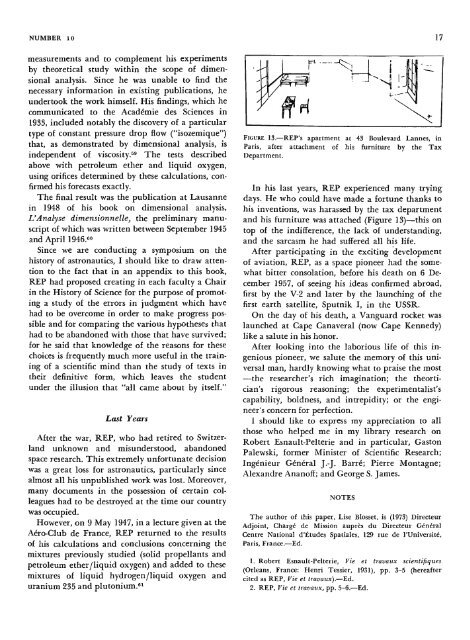FIRST STEPS TOWARD SPACE - Smithsonian Institution Libraries
FIRST STEPS TOWARD SPACE - Smithsonian Institution Libraries
FIRST STEPS TOWARD SPACE - Smithsonian Institution Libraries
Create successful ePaper yourself
Turn your PDF publications into a flip-book with our unique Google optimized e-Paper software.
NUMBER 10<br />
measurements and to complement his experiments<br />
by theoretical study within the scope of dimensional<br />
analysis. Since he was unable to find the<br />
necessary information in existing publications, he<br />
undertook the work himself. His findings, which he<br />
communicated to the Acad^mie des Sciences in<br />
1933, included notably the discovery of a particular<br />
type of constant pressure drop flow ("isozemique")<br />
that, as demonstrated by dimensional analysis, is<br />
independent of viscosity. 59 The tests described<br />
above with petroleum ether and liquid oxygen,<br />
using orifices determined by these calculations, confirmed<br />
his forecasts exactly.<br />
The final result was the publication at Lausanne<br />
in 1948 of his book on dimensional analysis,<br />
VAnalyse dimensionnelle, the preliminary manuscript<br />
of which was written between September 1945<br />
and April 1946. 60<br />
Since we are conducting a symposium on the<br />
history of astronautics, I should like to draw attention<br />
to the fact that in an appendix to this book,<br />
REP had proposed creating in each faculty a Chair<br />
in the History of Science for the purpose of promoting<br />
a study of the errors in judgment which have<br />
had to be overcome in order to make progress possible<br />
and for comparing the various hypotheses that<br />
had to be abandoned with those that have survived;<br />
for he said that knowledge of the reasons for these<br />
choices is frequently much more useful in the training<br />
of a scientific mind than the study of texts in<br />
their definitive form, which leaves the student<br />
under the illusion that "all came about by itself."<br />
Last Years<br />
After the war, REP, who had retired to Switzerland<br />
unknown and misunderstood, abandoned<br />
space research. This extremely unfortunate decision<br />
was a great loss for astronautics, particularly since<br />
almost all his unpublished work was lost. Moreover,<br />
many documents in the possession of certain colleagues<br />
had to be destroyed at the time our country<br />
was occupied.<br />
However, on 9 May 1947, in a lecture given at the<br />
Aero-Club de France, REP returned to the results<br />
of his calculations and conclusions concerning the<br />
mixtures previously studied (solid propellants and<br />
petroleum ether/liquid oxygen) and added to these<br />
mixtures of liquid hydrogen/liquid oxygen and<br />
uranium 235 and plutonium. 61<br />
FIGURE 13.—REP's apartment at 43 Boulevard Lannes, in<br />
Paris, after attachment of his furniture by the Tax<br />
Department.<br />
In his last years, REP experienced many trying<br />
days. He who could have made a fortune thanks to<br />
his inventions, was harassed by the tax department<br />
and his furniture was attached (Figure 13)—this on<br />
top of the indifference, the lack of understanding,<br />
and the sarcasm he had suffered all his life.<br />
After participating in the exciting development<br />
of aviation, REP, as a space pioneer had the somewhat<br />
bitter consolation, before his death on 6 December<br />
1957, of seeing his ideas confirmed abroad,<br />
first by the V-2 and later by the launching of the<br />
first earth satellite, Sputnik I, in the USSR.<br />
On the day of his death, a Vanguard rocket was<br />
launched at Cape Canaveral (now Cape Kennedy)<br />
like a salute in his honor.<br />
After looking into the laborious life of this ingenious<br />
pioneer, we salute the memory of this universal<br />
man, hardly knowing what to praise the most<br />
—the researcher's rich imagination; the theortician's<br />
rigorous reasoning; the experimentalist's<br />
capability, boldness, and intrepidity; or the engineer's<br />
concern for perfection.<br />
I should like to express my appreciation to all<br />
those who helped me in my library research on<br />
Robert Esnault-Pelterie and in particular, Gaston<br />
Palewski, former Minister of Scientific Research;<br />
Ingenieur General J.-J. Barre; Pierre Montagne;<br />
Alexandre Ananoff; and George S. James.<br />
NOTES<br />
The author of this paper, Lise Blosset, is (1973) Directeur<br />
Adjoint, Charge de Mission aupres du Directeur General<br />
Centre National d'Ltudes Spatiales, 129 rue de l'Universite,<br />
Paris, France.—Ed.<br />
1. Robert Esnault-Pelterie, Vie et travaux scientifiques<br />
(Orleans, France: Henri Tessier, 1931), pp. 3-5 (hereafter<br />
cited as REP, Vie et travaux).—Ed.<br />
2. REP, Vie et travaux, pp. 5-6.—Ed.<br />
17

















